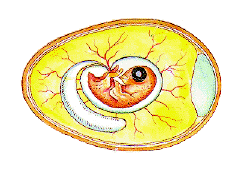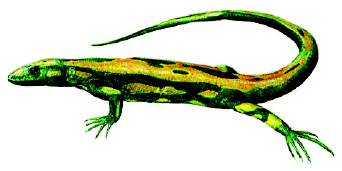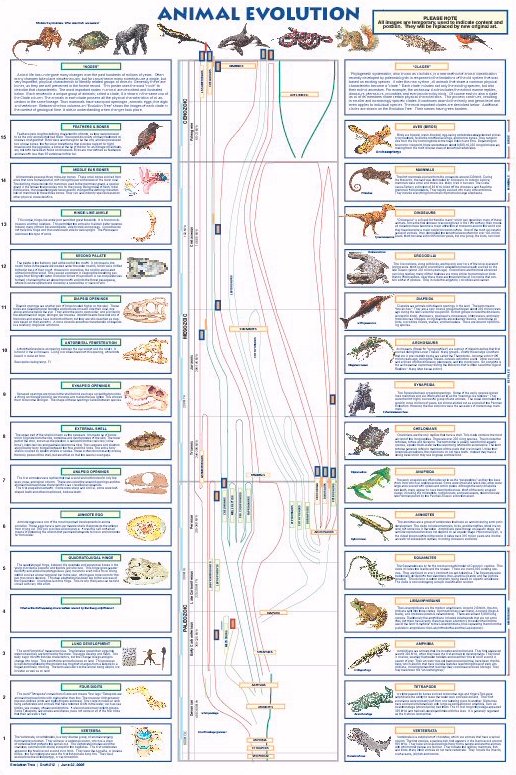|
|
|
The evolution of
"Milestones of Evolution" |
The creative process
requires making decisions. It begins with an idea, then another
is added, then still more. At some point, it becomes necessary
to integrate them. That requires going from the general to the
specific. We call this "concept development." It's first goal is
to clearly define the subject. Once that has been done, the
process is one of selection. You consider all the possibilities for
each element, then select the ones that contributes the most to the
goal.
We are usually able to move through this process rather
quickly, but this poster has been a very big exception. We have
long known the elements that we wanted to show, but have had great
difficulty integrating them into a cohesive concept. This page
summaries some of the steps. |
|
|
Two
years ago we ran across the above diagram showing the Evolution of
Life. It was a two page spread in the World Wildlife Atlas
published by the World Wildlife Fund in 1985. We thought the
"evolution bush" was
an outstanding presentation concept. It
shows how various branches split off. It is superimposed over
lines indicating geological time thus indicating when events took
place and the relative thickness of each branch indicates the
relative abundance or scarcity of different life forms at a given
time. A poster is far larger and would provide space for showing
far more species and detail. The above bush is now over 20 years old and
is great need of updating to reflect many recent prehistoric life
discoveries .
We were immediately aware that such a poster would require a tremendous amount of research.
This led to the decision to postpone creating it until we had
accumulated research from the development of other titles. |
 |
 |
| Amniotic Egg |
Hylonomus was one
of the first Amnioties |
|
DK
Publishing's Dinosaur Encyclopedia incorporates an excellent
feature. It shows the physical changes that resulted in new
animal life forms, which it refers to as "nodes." For example,
the amniotic egg was one of
the most important developments in animal evolution. These eggs have a
semi-permeable shells that protects the embryo from drying out. The
yolk provides a food source. It was this self-contained means of
protecting the unborn that permitted tetrapods to live in environments
far from water. It resulted in a new type of animal, the
amniotes. The above Evolution Bush lacked nodes.
We wanted our poster to incorporate them as they show why branches
split off.
Last year, we began
working on a poster that incorporated "nodes" to show animal
evolution. There was so much material to be covered that we
ended up having to spread it across two posters,
Invertebrate Evolution and Vertebrate Evolution. Each
showed the nodes and the resulting species. |
|
|
As we were working on the
highly detailed drafts, we recognized that these posters were too complex and detailed
for the popular market. We wanted ones that could
be understood by mid-school students, but yet be comprehensive enough
for the college student. We want our posters to be attractive as
well as
informative and suitable for the mass market. Thus the highly detailed
posters went on hold. Their great value was in the accumulation
of so much underlying research.
Four months ago, we began working on our Life on
Earth Collection 3. Each of these collections contains eight
titles and we try to vary the subject matter. We use the
creative process described above to select the titles. We have had
great success with our dinosaur posters, but wanted to do one on
prehistoric mammals, as it was a subject not previously covered by any
publisher. This led to the decision to do a complementary poster on
the existing mammals. We wanted a bird poster and one on arthropods,
but also recognized that we had not yet produced a poster on reptiles
and amphibians. We explored the possibility of an overview. |
|
|
The main element would be existing
species, but the idea of showing prehistoric species, an evolution
bush and nodes crept in. It quickly became apparent that that it
was simply too much material for one poster. However, it did lead to
the idea of doing a poster on animal evolution. We knew that
would be a time-consuming project, so we re-scheduled it for inclusion
in the Life on Earth Collection 4.
Some of our posters come together very quickly. To fill the
"reptile niche" in the Life on Earth 3 collection, we referred to our
Publishing Plan, which contains a list of over 600 possible titles.
It contains 18 possible reptile posters and we quickly selected one. It
took a relatively short time to research and finalize content.
Illustrations and production art were quickly accomplished and the
poster is almost ready for print. See: Exotic Lizards. |
|
 |
Meanwhile, we continued work
on the evolution poster. The first series of drafts were
based on a large tree shown in a horizontal format (not shown). It was too
confusing so we came up with the 2nd series of drafts. The above
is version 12. The left column shows the nodes and the
corresponding right column shows the resulting species. An
evolution tree occupies center stage, tying all the information
together.
This tested well with consumers, but our marketing
people felt that there was too much text. They pointed out that
our two best selling posters Butterflies of the World and Dinosaur
Evolution contained no text only captions. They wanted less words
and more pictures. We also realize the title did not accurately
describe the subject, so we changed to reflect the finalize concept:
Milestones of Evolution. |
|
Back to Milestones of Evolution |
|